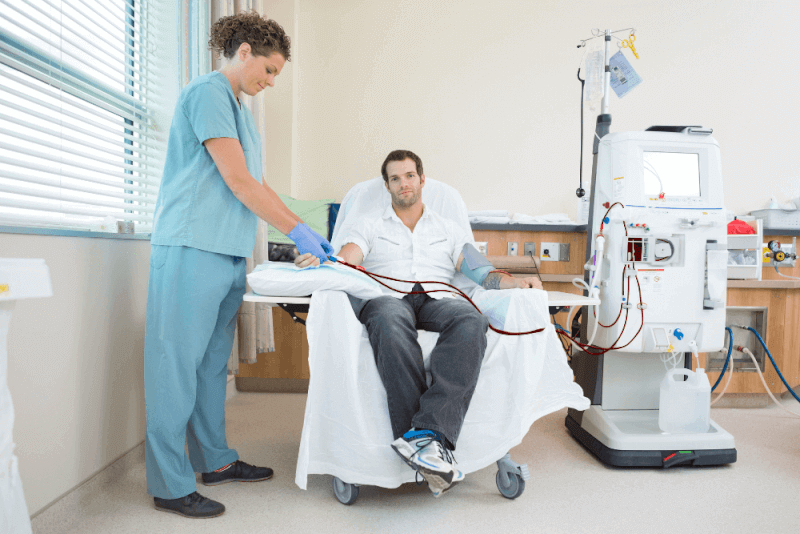What is swine flu (influenza)?
Swine flu, known for its similarity to seasonal flu, is commonly seen during January and February. Swine flu, which affects people of all ages, is also known as influenza A H1N1.
Swine flu is a contagious disease, and if not treated properly, it can lead to severe clinical conditions. The H1N1 virus, which was first observed in pigs, mutated and began infecting humans. It was first detected in Mexico in 2009 and spread worldwide within six months.
Swine flu (influenza) diagnosis methods
The treatment of swine flu begins with an accurate diagnosis. Since it shares common symptoms with seasonal flu, the diagnosis stage is extremely important. To differentiate swine flu from seasonal flu, microbiological testing is necessary. This involves conducting microchemical examinations of the patient's blood samples. In addition, various radiology techniques are also utilized. Alongside these tests, swab samples are taken from the patient's throat and nasal mucus, and a PCR test is performed.
Swine flu test
The diagnosis of swine flu is usually based on symptoms. However, if certain conditions are present, various tests, primarily blood tests, may be required. The purpose of these tests is to determine whether another illness is causing the symptoms. Examples of such conditions include:
- Heart issues like heart failure or myocarditis
- Respiratory problems with lung involvement such as asthma or pneumonia
- Neurological issues like encephalopathy or encephalitis
- Septic shock or organ failure
Symptoms of swine flu (influenza)
Many symptoms of swine flu are similar to those of seasonal flu. However, some symptoms may vary among patients. Common symptoms include:
- Fever
- Fatigue
- Headache
- Body aches
- Sore throat
- Chills
- Nasal congestion
- Shivering
- Loss of appetite
- Occasionally diarrhea
- Cough
Diagnosing swine flu in infants and children is more challenging. Therefore, the following symptoms should be carefully observed:
- Difficulty waking up
- Fever
- Rashes caused by fever
- Reluctance to drink fluids
- Irritability
- Difficulty breathing
- Confusion
Causes of swine flu (influenza)
Swine flu is caused by the H1N1 virus. This virus initially infects the upper respiratory tract and then quickly spreads to the lower respiratory tract. Once the virus enters the body, the incubation period begins, lasting between 1 to 4 days.
Swine flu (influenza) treatment methods
Mild cases of swine flu can be treated at home. Recommended home treatments include:
- Increased fluid intake
- Use of fever-reducing medications
- Rest
- Use of various medications to manage pain
- Use of medications recommended for nasal congestion
In severe cases of swine flu, hospitalization is necessary. Hospital treatment involves the use of antiviral medications and various vitamin supplements. Additional treatments may be required if shortness of breath worsens.
Swine flu (influenza) in infants
Swine flu can lead to more dangerous clinical outcomes in children and infants. It is also more challenging to diagnose compared to adults, so symptoms in children should be closely monitored.
If children or infants have swine flu, they should be kept in bed to rest. The room where they are resting should be ventilated frequently, and plenty of oxygen should be provided.
During the illness, children and infants tend to eat less. Therefore, their diet should consist of foods rich in vitamins and minerals. Additionally, since swine flu is characterized by high fever, attention should be given to increasing fluid intake.
It is crucial to ensure that medications are used regularly. If pneumonia develops, infants and children should be treated in the hospital.
What helps with swine flu?
To prevent swine flu from worsening and to support treatment, the following measures can be taken:
- As with other types of influenza, rest is extremely important in swine flu. By avoiding additional strain on the body, more energy can be allocated to the immune system.
- Sweating profusely helps remove toxins from the body. Sweating is beneficial for overall health as well as for cleansing the body of waste products accumulated due to the virus.
- Consuming fluids such as water, fruit juice, and soup helps maintain the body's electrolyte balance. However, coffee should be avoided, and herbal teas should be consumed cautiously and in moderation.
- Ginger or turmeric tea with honey and lemon can help eliminate infection in the body. However, if medication is being used, it is important to consult a doctor to avoid any potential interactions.
- Broth soups, such as those made from meat or chicken, provide hydration and help strengthen the immune system.
- Taking a hot shower helps relieve muscle pain.
- Inhaling steam helps open the airways, allowing more oxygen into the body.
- Gargling with salt water helps reduce the viral population in the mouth and throat.
- Throat lozenges help soothe the throat and reduce the severity of throat-related symptoms.
- Garlic is recommended for consumption as it is one of the most powerful natural infection-fighting foods.
- Consuming foods and drinks rich in vitamin C can help support the immune system.
When should you see a doctor?
Due to the similarity between the symptoms of H1N1 swine flu and seasonal flu, many people do not seek medical attention. However, if the following symptoms occur, medical help should be sought:
- Severe or persistent vomiting
- Sudden dizziness
- Difficulty breathing
- Confusion
- Abdominal pain
- Chest pain
In children with swine flu, the following symptoms require urgent medical attention:
- Dehydration
- High fever
- Rash
- Irritability
- Flu symptoms that improve but return with more severe signs
- Bluish skin color
- Weakness
- Rapid breathing
- Difficulty breathing
Differences between swine flu (influenza) and COVID-19
Swine flu and COVID-19 are two diseases that affect the respiratory tract. However, they are caused by different viruses. Common symptoms of swine flu and COVID-19 include:
- Fever
- Chills
- Cough
- Shortness of breath
- Sore throat
- Runny nose
- Nasal congestion
- Body aches
- Vomiting
- Diarrhea
The most significant difference between swine flu and COVID-19 is the loss of taste and smell in COVID-19. Additionally, the symptoms caused by COVID-19 last longer than those of swine flu.
How to protect yourself from swine flu?
To protect yourself from swine flu, the following precautions should be taken:
- Washing hands frequently and thoroughly
- Avoiding crowded places, especially in January and February
- Disinfecting door handles and faucet heads frequently in crowded places
- Avoiding close contact with sick individuals
- Sick individuals should wear masks and avoid social environments
- Maintaining cleanliness of personal items used at home
- Getting vaccinated against the H1N1 virus
Who should get the flu (influenza) vaccine?
Some individuals are at higher risk of contracting swine flu. It is recommended that these risk groups do not neglect to get the H1N1 vaccine. These individuals include:
- Healthcare workers
- People over 50 years old
- Pregnant women
- Those receiving palliative care
- Individuals with autoimmune diseases
- Residents of nursing homes
- Diabetics
- Individuals with chronic lung and heart diseases
- Individuals with chronic kidney disease.
Is swine flu contagious?
Swine flu is a disease that can be transmitted through airborne particles. It can spread through droplets released into the air when a sick person talks, sneezes, or coughs.
The contagiousness of swine flu begins one day before symptoms appear. Therefore, a person can spread the virus even before they know they are sick. The risk of transmission continues until the seventh day after symptoms appear.
During this period, isolating the sick person from the community can help reduce the risk of transmission. The sick person should also wear a mask and maintain personal hygiene.
How long does swine flu last?
The most characteristic symptom of swine flu is a high fever that lasts up to 5 days and cannot be reduced. In individuals who are healthy and have no chronic illnesses, the symptoms of swine flu are expected to resolve within a week. However, if the person's general health is compromised, this process may take longer.
Is swine flu dangerous?
Swine flu can lead to extremely serious medical conditions, especially in individuals with other health problems. Potential complications of swine flu include:
- Worsening of chronic conditions like heart disease or chronic asthma
- Lung inflammation
- Neurological problems ranging from confusion to seizures
- Respiratory failure
- Bronchitis
- Muscle sensitivity
- Bacterial infections
Complications like lung infection and respiratory failure can put patients' lives at risk.
Is swine flu fatal?
The H1N1 virus that causes swine flu is not powerful enough on its own to be life-threatening. However, the complications it can cause may put patients' lives at risk. Those at particular risk include:
- Individuals with chronic illnesses
- People under 2 years old and over 65 years old
- Individuals with a suppressed immune system for any reason
- People with metabolic diseases like diabetes
Swine flu and persistent fever
The most distinguishing symptom of swine flu from other types of influenza is a high fever. Even in healthy individuals, a high fever can persist for 5 days, ranging between 39-40 degrees Celsius. It is possible for the fever to exceed 40 degrees and may not respond to fever reducers.







